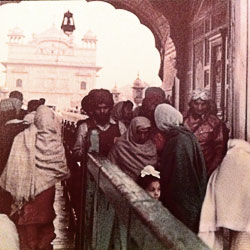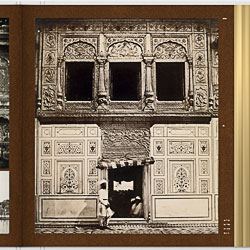| The Maharaja, the Spy & the Temple of Gold | ||||||||||||||||
|
There is little more daunting than the burning stare of a blank page waiting to be filled with the introduction to a new book. And so it was with the task of writing the opening chapter of ‘The Golden Temple of Amritsar: Reflections of the Past (1808-1959)‘. The book’s incredible collection of 500 images had been painstakingly compiled over almost two decades, as had the dozens of quotations and writings of various travellers, pilgrims and officials, perfectly complementing the visual material. However, my co-editor Parmjit Singh and I had given little thought to how to introduce the subject itself.
Patwant Singh in his book on the Golden Temple takes the reader through a typical day at the Harimandir Sahib and uses that to whip them through the modern day goings-on at the complex. Other writers of history have taken a much more pedestrian approach and stuck to a simple chronology of events. Our book is neither an explication of today’s rituals nor is it a simple history book. It is a visual evolution of the shrine, its impact on the holy city of Amritsar and the changing fortunes of the Sikh people. The story is told through images and the travellers’ notes spanning 150 years that bear witness to these changes. They are also testimony to the impact of the Harimandir Sahib on a wide variety of people over the years. And it was something in these travellers’ extracts that gave me the inspiration for the opening chapter.
Before me, I realised, a guide of some kind had performed the same service for almost every other visitor. That became the genesis of the idea to use one of the historic visitors to the temple as a guide for our readers. The one early European visitor that sits apart from almost every other is the colourful Captain Arnold Mathews (1765-1820). Not only did he have primacy, he also witnessed something that none of the others would see after him—the Golden Temple before it was adorned with gold. During the summer run of the Golden Temple exhibition one fact seemed to astound many of our 22,000 visitors, namely that the gold was a relatively recent innovation that owes its existence to Maharaja Ranjit Singh. By virtue of Mathews’ incompetence as a spy, he was captured and given a glimpse of the temple while Ranjit Singh was still carrying out the gilding process.
A Player of the Great Game In the first decade of nineteenth-century India, that role was often left to military men such as Captain Arnold Mathews. With the connivance of his superiors in Calcutta, he attempted to gather military and logistical information on the strategically vital and wealthy Sikh Empire that held court at Lahore, Punjab’s imperial capital, perched on the northern stretch of the Grand Trunk Road.
He remains a somewhat enigmatic character to this day. The eldest son of the first Earl of Landaff, he joined the Bengal Artillery in 1783, eventually rising to the rank of major. Strangely, he elected to remain in India after his father’s death and to forego his claim to the peerage for reasons unknown. There is a suggestion that he died a convert to Islam, but this is by no means certain. He was buried at Chinsurah, West Bengal, in 1820 where his gravestone still exists. Foreign Spies in the Kingdom of Five Rivers Almost from the moment in 1757, when Robert Clive first governed Indian land in the Company’s name, London was preoccupied with the notion that this dazzling oriental jewel would be plucked from the Imperial crown through a land invasion from the Northwest. Standing between Britain’s Indian territories and the ancient mountain passes into Afghanistan and beyond was the nascent empire of a wily young Sikh warlord, Ranjit Singh (1780-1839). His dominions were the fertile plains of the Punjab, fed by five mighty rivers, which unfurled from the Khyber Pass in the north towards the great Mughal capital of Delhi to the south. This chequered landscape had witnessed many epic battles and, from the eleventh century onward, repeated invaders, including Mughals, Persians and Afghans, ensuring that this land would forever be known as the real gateway into India. And it was from this thoroughfare that the British feared another incursion. Ranjit Singh’s kingdom was one of the few remaining independent powers in India and was a most vital one, not only as the point of entry into the subcontinent but also as a critical buffer state between British India and Afghanistan. Yet despite this, the Company was ultimately in no mood for an alliance with the capable and clever Sikh, with whom they remained on cordial yet uneasy terms. So while Ranjit Singh was subduing rivals within Punjab and consolidating his acquisitions, the British pursued an uncompromising and expensive ‘forward policy’ with a view to elevating the Company’s position to that of the paramount power in India.
The subjugation of the Maratha confederacy and the conquest of Delhi in 1803 was a move calculated to ensure access to the financial resources necessary to curb the ever-looming menace of invasion. Indeed, as wary as the British were of Franco-Russian designs in Afghanistan, they were also plagued by suspicions of the strategic intentions of their Sikh neighbour. The success or failure of any British military campaign against Ranjit Singh would be determined as much by detailed reliable intelligence as by tactics or sheer firepower. With that firmly in mind, Captain Mathews was allowed six months’ leave of absence in the spring of 1808 for the purpose of espionage in the Kingdom of Five Rivers. A Most Conspicuous Spy His ruse upon entering the Sikh kingdom was to travel in an unofficial capacity for ‘private amusement’ as a tourist en-route to Kashmir. Ranjit Singh, however, maintained a simple border policy at that time: foreigners were not to be permitted within the boundaries of his country. It was an effective and uncomplicated method of dissuading foreign spies, and as far as desisting white-skinned European travellers was concerned, relatively straightforward to police. As such, Mathews’ mission was something of an embarrassing failure. He was quickly intercepted, brought directly to Lahore and kept under a watchful eye. Ranjit Singh lavished hospitality and humiliation in equal measure on his uninvited guest and his paymasters in Calcutta. Matthews was eventually sent packing with a letter telling them, in no uncertain terms, that the British were not, in fact, being particularly ‘British’. The Accidental Tourist It was in May 1808 that he laid his eyes on the Harimandir Sahib or Temple of Hari, an alluring shrine that seemingly floated on the tranquil waters of a large tank.
Arriving in the city he stated it was considered ‘a place of great wealth and opulence’ and an important commercial hub. ‘It is the grand emporium of trade for shawls and saffron from Cashmeer, and a variety of other commodities from the Dukkun and eastern parts of India.’ Upon seeing the temple itself he recorded his admiration in correspondence to his superiors. He described a ‘pretty temple…to which you go by a causeway. It is neatly decorated, both within and without, and the rajah is making additional ornamented work to it at his own expense.’ Remarkably, Mathews makes no mention of the gold that has otherwise dazzled and amazed subsequent visitors. He had arrived at a pivotal moment in the temple’s history. An accidental tourist and unconvincing spy he may have been but he was also eyewitness to the dawn of the shrine’s golden era. Ranjit Singh had only recently wrested control of Amritsar and was in the process of embarking upon a programme of patronage and good governance that would see both the city and shrine utterly transformed, and seal his reputation as ruler of the rising new empire. The work-in-progress witnessed by Mathews would conclude with the entire upper storey and roof being lavishly covered with gilt-copper panels, giving rise to its popular name, Svarn Mandir or Golden Temple, in the eventful years to come. Eyewitness to Sikh Culture
‘A Sik’h wishing to become a Singh,’ he remarked, ‘finds no difficulty in accomplishing his proselytism. He goes to the Akalees, or priests of the sect, at Amrutsur, who ask him if he wishes to become a convert to their persuasion….and after the performance of certain ceremonies, he is given to drink a sherbet made of sugar and water, from the hand of an Akalee. After this initiation, he never shaves his beard, nor cuts his hair…Now become a Singh, he is heterodox, and distinct from the Hindoos…’ He also noted how ‘Choirs of singers assemble at three o’clock every morning, and chaunt their canticles by reliefs, during the day, and till late at night, in the temple; and at two or three other sacred spots, and with great solemnity, thus exciting to religious veneration and awe…’ On one occasion such singers, accompanied by traditional instruments including the rabab, were sent to his tent by the temple priests. So struck was Mathews by their beauteous renditions that he couldn’t help but note their affect as ‘transporting the soul to heavenly musings; and although in so different a language from the songs of David, they strike the ear as compositions of the same kind, and are all in praise of the attributes and unity of God.’ Mathew’s ‘accidental tourist’ diary entries describing the Harimandir Sahib are believed to be not only the first by a non-Sikh, but also the first recorded account of the temple anywhere in the world. Learn More
About the Author He is currently working on a special edition of ‘Warrior Saints’, due to be published in 2012. He is chair of the UK Punjab Heritage Association (ukpha.org), a voluntary body committed to preserving the culture and heritage of the Sikhs and Punjab. Amandeep works as a director of supply chain logistics at a major pharmaceutical company. |










